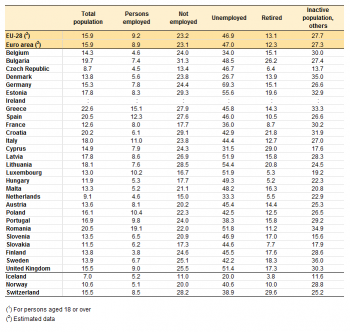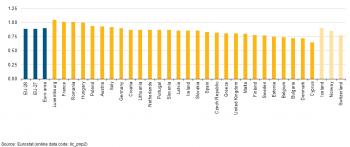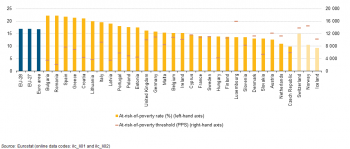Archive:Income poverty statistics
- Data from July 2013, most recent data: Further Eurostat information, Main tables and Database. Planned article update: April 2014.

(%) - Source: Eurostat (ilc_li04)

(% of specified population) - Source: Eurostat (ilc_li03)

(%) - Source: Eurostat (ilc_li02) and (ilc_li10)

(income quintile share ratio) - Source: Eurostat (ilc_di11)

(ratio of the median equivalised disposable income of people aged 65 and above to the median equivalised disposable income of those aged below 65) - Source: Eurostat (ilc_pnp2)
This article analyses recent statistics on monetary poverty and income inequalities in the European Union (EU). Comparisons of standards of living between countries are frequently based on gross domestic product (GDP) per capita — which presents in monetary terms how rich one country is compared with another. However, this headline indicator says very little about the distribution of income within a country and also fails to provide information in relation to non-monetary factors that may play a significant role in determining the quality of life of a particular population. On the one hand, inequalities in income distribution may create incentives for people to improve their situation through work, innovation or acquiring new skills. On the other hand, such income inequalities are often viewed as being linked to crime, poverty and social exclusion.
Main statistical findings
At-risk-of-poverty rate and threshold
In 2011, 16.9 % of the EU-28 population was assessed to be at-risk-of-poverty after social transfers (see Figure 1). This share, calculated as a weighted average of national results, conceals considerable variations across the EU Member States. In six countries, namely Bulgaria (22.3 %), Romania (22.2 %), Spain (21.8 %), Greece (21.4 %), Croatia (21.1 %) and Lithuania (20.0 %), one fifth or more of the population was viewed as being at-risk-of-poverty. The lowest proportions of persons at-risk-of-poverty were observed in the Netherlands (11.0 %) and the Czech Republic (9.8 %). Norway (10.5 %) and Iceland (9.2 %) also reported relatively low shares of their respective populations as being at-risk-of-poverty.
The at-risk-of-poverty threshold (also shown in Figure 1) is set at 60 % of national median equivalised disposable income. It is often expressed in purchasing power standards (PPS) in order to take account of the differences in the cost of living across countries. This threshold varied considerably among the EU Member States in 2011 from PPS 2 134 in Romania, PPS 3 400 in Latvia and PPS 3 420 in Bulgaria to a level between PPS 11 000 and PPS 12 150 in Sweden, Denmark, the Netherlands, Cyprus and Austria, before peaking in Luxembourg at PPS 16 001; the poverty threshold was also relatively high in Norway and Switzerland (exceeding PPS 13 000 in both of these countries).
Overall, the at-risk-of-poverty rate (after social transfers) in the EU-27 was stable between 2009 and 2010 (see Table 1) before increasing between 2010 and 2011. Between 2010 and 2011, the at-risk-of-poverty rate increased by at least 1.5 percentage points in Estonia, Bulgaria and Hungary. On the other hand, the largest reduction occurred in Latvia (a fall of 2.2. percentage points), although this could, at least in part, be due to the reported break in series in 2011. The United Kingdom, Ireland, Luxembourg, Cyprus, Denmark and Lithuania also reported a decrease in their respective at-risk-of-poverty rates between 2010 and 2011, as did Norway and Iceland. All the other countries reported increases, ranging from 0.1 percentage points in Poland and Portugal to 1.7 percentage points in Estonia.
Different groups in society are more or less vulnerable to monetary poverty. There was a relatively small difference in the at-risk-of-poverty rate (after social transfers) for the two sexes in the EU-28 in 2011: 16.1 % for males compared with 17.6 % for females. The largest differences (both 3.5 percentage points) were observed in Cyprus (12.7 % for males and 16.2 % for females) and Sweden (12.2 % for males and 15.7 % for females). Bulgaria, the United Kingdom and Slovenia all reported that female at-risk-of-poverty rates were 2.8 percentage points higher in 2011 than the corresponding rates for males, while in Switzerland the difference was 2.6 percentage points. By contrast, there were five EU Member States where the at-risk-of-poverty rate was slightly higher among men than women, namely Latvia, Ireland, Hungary, Estonia and Poland.
The differences in poverty rates were wider when the population was classified according to activity status (see Table 2). The unemployed are a particularly vulnerable group: almost half (45.9 %) of all unemployed persons in the EU-28 were at-risk-of-poverty in 2011, with by far the highest rate in Germany (67.8 %) , while four other Member States (Bulgaria and the three Baltic Member States) reported that slightly more than half of the unemployed were at-risk-of-poverty in 2011. One in seven (14.1 %) of all retired persons in the EU-28 were at-risk-of-poverty in 2011; rates that were at least twice as high as the EU-28 average were recorded in Cyprus (36.8 %) and Bulgaria (28.3 %). Those in employment were far less likely to be at-risk-of-poverty (an average of 8.9 % across the whole of the EU-28). There were relatively high proportions of employed persons at-risk-of-poverty in Romania (18.9 %) and to a lesser extent in Spain (12.3 %) and Greece (11.9 %), while Poland, Italy, Portugal and Lithuania each reported that in excess of 1 in 10 members of their respective workforces were at-risk-of-poverty in 2011.
At-risk-of-poverty rates are not uniformly distributed between households with different compositions of adults and dependent children, as can be seen from Table 3. For the EU-28 as a whole, single person households with dependent children were the group most at-risk-of-poverty (34.5 %), followed by single person households (25.7 %), and households with two adults and three or more dependent children (24.8 %). On the other hand, persons living in households with two or more adults without dependent children were the least at-risk (11.2 %), followed by those living in households with two adults with at least one aged over 65 as well as households with two adults and one dependent child (both 12.7 %). In summary, the greater the number of dependent children living in a household (with either two adults or a single person), the greater the risk of poverty. This was more or less the picture in most EU Member States, although there were some exceptions. In Bulgaria, Spain, Italy, Hungary, Poland, Portugal, Romania and Slovakia, the most at risk were those living in households composed of two adults with three or more dependent children. Exceptionally, in Cyprus the persons most at risk (among those categories shown in the table) were those living in households with at least one elderly person (36.9 %). Moreover, in Denmark, Croatia, Cyprus, Slovenia and Finland, the percentage of the population that was found to be at-risk-of-poverty in single person households without dependent children was higher than the percentage of those found in single person households with dependent children; this was also the case in Norway.
Social protection measures can be used as a means for reducing poverty and social exclusion. This may be achieved, for example, through the distribution of benefits. One way of evaluating the success of social protection measures is to compare at-risk-of-poverty indicators before and after social transfers (see Figure 2). In 2011, social transfers reduced the at-risk-of-poverty rate among the population of the EU-28 from 26.3 % before transfers to 16.9 % after transfers, thereby lifting 35.7 % of persons that would otherwise be at-risk-of-poverty above the poverty threshold. Measured in this way, the relative impact of social benefits was lowest in Greece, Italy and Bulgaria. By contrast, half or more of all persons who were at-risk-of poverty in Ireland, Denmark, Hungary, Finland and Luxembourg moved above the threshold as a result of social transfers, as was the case in Norway and Iceland; in Sweden and Austria the proportion of persons moved above the poverty threshold through the impact of social benefits was just below one half.
Income inequalities
Governments, policymakers and society in general cannot combat poverty and social exclusion without analysing the inequalities within society, whether they are economic or social in nature. Data on economic inequality become particularly important for estimating relative poverty, because the distribution of economic resources may have a direct bearing on the extent and depth of poverty (see Figure 3). There were wide inequalities in the distribution of income in 2011: As a population-weighted average of EU-28 Member States’ national figures the top 20 % (highest equivalised disposable income) of a Member State’s population received 5.1 times as much income as the bottom 20 % (lowest equivalised disposable income) of the Member State’s population. This ratio varied considerably across the EU-28 Member States, from 3.5 in Slovenia and the Czech Republic, to at least 6.0 in Greece, Romania, Bulgaria and Latvia, peaking at 6.8 in Spain.
There is policy interest in the inequalities felt by many different groups in society. One group of particular interest is that of the elderly, in part reflecting the growing proportion of the EU’s population that is aged over 65 years. Pension systems can play an important role in addressing poverty among the elderly. In this respect, it is interesting to compare the incomes of the elderly with the rest of the population. Across the EU-28 as a whole, people aged 65 and above had a median income which in 2011 was equal to 89 % of the median income for the population under the age of 65 (see Figure 4). In four countries (Luxembourg, France, Romania and Hungary) the income of the elderly was equal to or higher than the income of persons under 65. In Poland, Austria, Italy and Germany the median income of the elderly was at least 90 % of that recorded for people under 65; this was also the case in Iceland. By contrast, the elderly in Cyprus had median incomes that were equal to 65 % of those recorded for people under 65. Ratios between 70 % and 80 % were recorded in Denmark, Bulgaria, Belgium, Estonia, Sweden and Finland; these relatively low ratios may broadly reflect pension entitlements.
The depth of poverty, which helps to quantify just how poor the poor are, can be measured by the relative median at-risk-of-poverty gap. The median income of persons at-risk-of-poverty in the EU-28 was, on average, 23.4 % below the poverty threshold in 2011; this threshold is set at 60 % of the national median equivalised disposable income of all persons. Among the countries shown in Figure 5, the relative median at-risk-of-poverty gap was widest in Latvia and Romania (both 31.8 %), Spain (30.8 %), Bulgaria (30.0 %), Lithuania (28.7 %) and Croatia (27.4 %), followed by Greece, Estonia and Italy (all around 26 %). The lowest at-risk-of-poverty gap among the EU Member States was observed in Finland (13.5 %), followed by the Netherlands (15.5 %) and Luxembourg (15.7 %).
Data sources and availability
EU statistics on income and living conditions (EU-SILC) were launched in 2003 on the basis of a gentlemen’s agreement between Eurostat, six EU Member States (Austria, Belgium, Denmark, Greece, Ireland, Luxembourg) and Norway. EU-SILC was implemented in order to provide underlying data for indicators relating to income and living conditions — the legislative basis for the data collection exercise is Regulation 1177/2003 of the European Parliament and of the Council. The collection of these statistics was formally launched in 2004 in 15 countries and expanded in 2005 to cover all of the remaining EU-25 Member States, together with Iceland and Norway. Bulgaria and Turkey launched EU-SILC in 2006, Romania in 2007, Switzerland in 2008, while Croatia introduced the survey in 2010 (2009 data for Croatia are based on a different data source — namely the household budget survey (HBS)). EU-SILC comprises both a cross-sectional dimension and a longitudinal dimension.
Household disposable income is established by summing up all monetary incomes received from any source by each member of the household (including income from work, investment and social benefits) — plus income received at the household level — and deducting taxes and social contributions paid. In order to reflect differences in household size and composition, this total is divided by the number of ‘equivalent adults’ using a standard (equivalence) scale, the so-called ‘modified OECD’ scale, which attributes a weight of 1.0 to the first adult in the household, a weight of 0.5 to each subsequent member of the household aged 14 and over, and a weight of 0.3 to household members aged less than 14. The resulting figure is called equivalised disposable income and is attributed to each member of the household. For the purpose of poverty indicators, the equivalised disposable income is calculated from the total disposable income of each household divided by the equivalised household size; consequently, each person in the household is considered to have the same equivalised income.
The income reference period is a fixed 12-month period (such as the previous calendar or tax year) for all countries except the United Kingdom for which the income reference period is the current year of the survey and Ireland for which the survey is continuous and income is collected for the 12 months prior to the survey.
The at-risk-of-poverty rate is defined as the share of people with an equivalised disposable income that is below the at-risk-of-poverty threshold (expressed in purchasing power standards — PPS), set at 60 % of the national median equivalised disposable income. In line with decisions of the European Council, the at-risk-of-poverty rate is measured relative to the situation in each EU Member State rather than applying a common threshold. The at-risk-of-poverty rate may be expressed before or after social transfers, with the difference measuring the hypothetical impact of national social transfers in reducing the risk of poverty. Retirement and survivors’ pensions are counted as income before transfers and not as social transfers. Various analyses of this indicator are available, for example: by age, sex, activity status, household type, or education level. It should be noted that the indicator does not measure wealth but is instead a relative measure of low current income (in comparison with other people in the same country), which does not necessarily imply a low standard of living. The EU-28 and EU-27 aggregates are population-weighted averages of individual national figures.
Context
At the Laeken European Council in December 2001, European heads of state and government endorsed a first set of common statistical indicators for social exclusion and poverty that are subject to a continuing process of refinement by the indicators sub-group (ISG) of the social protection committee (SPC). These indicators are an essential element in the open method of coordination to monitor the progress made by the EU’s Member States in alleviating poverty and social exclusion.
EU-SILC is the reference source for EU statistics on income and living conditions and, in particular, for indicators concerning social inclusion. In the context of the Europe 2020 strategy, the European Council adopted in June 2010 a headline target for social inclusion — namely, that by 2020 there should be at least 20 million fewer people in the EU than were in 2008 who are at risk of poverty or social exclusion. EU-SILC is the source used to monitor progress towards this headline target, which is measured through an indicator that combines the at-risk-of-poverty rate, the severe material deprivation rate, and the proportion of people living in households with very low work intensity — see the article on social inclusion statistics for more information.
See also
- Children at risk of poverty or social exclusion
- Housing statistics
- Housing conditions
- Over-indebtedness and financial exclusion statistics
- People at risk of poverty or social exclusion
- Social inclusion statistics
Further Eurostat information
Publications
- Living standards falling in most Member States Statistics in focus 8/2013
- Children were the age group at the highest risk of poverty or social exclusion in 2011 Statistics in focus 4/2013
- In 2009 a 6.5 % rise in per capita social protection expenditure matched a 6.1 % drop in EU-27 GDP Statistics in focus 14/2012
- 23 % of EU citizens were at risk of poverty or social exclusion in 2010 Statistics in focus 9/2012
- 51 million young EU adults lived with their parent(s) in 2008 Statistics in focus 50/2010
- Combating poverty and social exclusion. A statistical portrait of the European Union 2010
- Income and living conditions in Europe (2010)
- Over-indebtedness of European households in 2008 Statistics in focus 61/2010
- The life of women and men in Europe – A statistical portrait (available in English, French and German)
- The Social Situation in the European Union 2009
Main tables
- Living conditions and welfare (t_livcon), see:
Database
- Living conditions and welfare (livcon), see:
- Income and living conditions (ilc)
- Income distribution and monetary poverty (ilc_ip)
- Monetary poverty (ilc_li)
- Monetary poverty for elderly people (ilc_pn)
- Distribution of income (ilc_di)
- Income distribution and monetary poverty (ilc_ip)
Dedicated section
Methodology / Metadata
- Income and living conditions (ESMS metadata file - ilc_esms)
- Comparative EU Statistics on Income and Living Conditions: Issues and Challenges (Proceedings of the International Conference on EU Comparative Statistics on Income and Living Conditions, Helsinki, 6-8 November 2006 )
Source data for tables and figures (MS Excel)
Other information
- Regulation 1177/2003 of 16 June 2003 concerning Community statistics on income and living conditions (EU-SILC)
- Regulation 1553/2005 of 7 September 2005 amending Regulation 1177/2003 concerning Community statistics on income and living conditions (EU-SILC)
- Regulation 1791/2006 of 20 November 2006 adapting certain Regulations and Decisions in the fields of ... statistics, ..., by reason of the accession of Bulgaria and Romania
External links
- EU Employment and Social Situation Quarterly Review - March 2013
- Employment and Social Developments in Europe (2012)
- OECD - Better Life Initiative: Measuring Well-being and Progress


